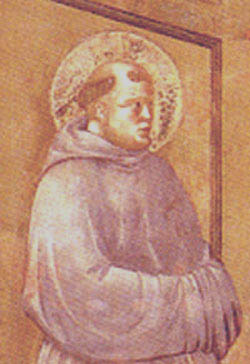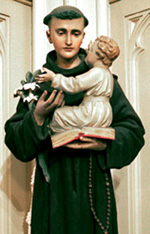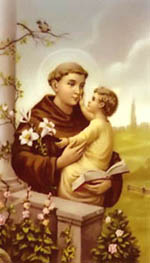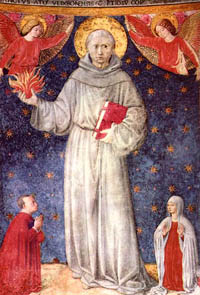 |
The Saint of the Day
St. Anthony of Padua – June 13
Prof. Plinio Corrêa de Oliveira
Today is the feast day of St. Anthony of Padua, called "Ark of the Covenant" for his profound knowledge of Scriptures and "Hammer of Heretics" for his skill in applying that knowledge in polemics. It is customary in the churches of many Western nations to place the statue of St. Anthony in a special place of honor to be venerated by the faithful on his feast day.

A close-up of St. Anthony in Giotto's
The Apparition at Arles
|
When I visited Assisi in 1950, I admired a picture of the Saint painted by Giotto, which is said to be the image most closely resembling him that exists. It presents a strong man with a thick bull-like neck, a serious expression, an imperious gaze, and a majestic attitude that gives the impression of the Doctor of the Church he was later declared to be. I bought some reproductions of this picture by Giotto.
I also bought another picture that represented St. Anthony that was sold at the door of the church. This one was not by Giotto, but by some unknown author who portrayed the common picture of St. Anthony. It showed a young man with soft skin, pink cheeks, and the mindless and somewhat foolish air of one who does not understand anything. In his arms he is holding a Child Jesus, who appears to not understand what he is doing in the arms of that man. He has the air of someone who says: "I am sorry to be here, it probably happened by some mistake. But it seems that we will still have to bear this for a while." In St. Anthony's face, there is nothing that expresses the Doctor of the Church, the man who was considered the greatest expert in Scriptures of his time.
He knew everything in Scriptures and used to quote it by heart; he knew even its most arcane and difficult passages. He was not only able to quote such texts, but used to comment on them and draw concrete consequences from them to smash the heretics and to encourage the faithful.


The militant character of St. Anthony has been distorted by soft, sentimental portrayals
|
He was also an extraordinary polemicist who would debate the heretics not have ecumenical dialogues with them, let me note in passing and destroy them by demolishing their arguments. God used to confirm His support for St. Anthony by working miracles while he was preaching. This twofold show of arms: a powerful debate followed by miracles was what earned him the title "Hammer of Heretics." His life had nothing to do with the insipid and ecumenical St. Anthony presented on the holy cards that so many people have.
The militant St. Anthony is the authentic one, depicting the way he lived on earth in his times and the way he is now in Heaven. But today his true moral physiognomy, which the Church presents as a model, has almost completely disappeared. The figure that replaced him is a sentimental one only concerned about giving graces and favors. There is a fundamental difference in the physical figure, but most of all, there is a fundamental difference in the moral figure of St. Anthony.
In addition to being honored with the aforementioned titles "Ark of the Covenant and Hammer of the Heretics" St. Anthony is also the Patron of the Army. The reason for that is linked to two incidents where, from Heaven, he intervened in a militant way.
The first was when a Spanish fleet was besieging the Muslim city of Oram and facing a long and fruitless siege. In such circumstance, the Spanish Admiral went to a statue of St. Anthony to ask his intercession. He told St. Anthony that he, the Admiral, could do nothing more without some extraordinary help. Then he turned over his insignias of command to the statue and placed his Admiral's hat on its head. Then he asked St. Anthony to take command of the siege against Oram and conquer the city.
Soon after this, the Moors suddenly left the city. Some who were captured and interrogated related that they had seen a Friar coming from Heaven with an Admiral's hat on his head. He threatened the Moors that he would send fire from Heaven upon them unless they left the city. In face of this peril, the Muslims found it more prudent to leave.
The second incident took place in Rio de Janeiro when it was being attacked by the French Calvinist fleet. The Calvinists had a great advantage over the Brazilian Catholics, who could no longer offer an effective resistance. At that point, the Franciscan Friars took a statue of St. Anthony from their monastery to a central square in Rio and set it on a column.

Above, St. Anthony threatening the enemies with heavenly fire - Painting by Benozzo Gozzoli
|
The simple presence of the statue began to provoke a general enthusiasm for the fight. Very soon a large number of young men entered the army. With this, it was possible to retake lost positions, reorganize the resistance and make an efficacious counter-attack. In a short time, the Calvinists were defeated and left the Brazilian shore. The fact that Brazil did not become a Calvinist country is due in no small part to that marvelous presence of a statue of St. Anthony.
The common devotion to St. Anthony normally does not mention things like this. He is presented as a sweet, foolish saint who only likes to arrange marriages and enjoy his feast day. This kind of sentimental piety distorted the physiognomy of the great St. Anthony to hide his militancy.
I think that we have the obligation to correct this false piety and help restore the true moral physiognomy of the saints. For it is easy to see that this distortion has been effected not only with St. Anthony, but also with many other saints.
Let us ask St. Anthony to give us the necessary graces to help extirpate this false piety and to become enthusiastic admirers of Catholic militancy, as he was.


More on St. Anthony

  | | Prof. Plinio Corrêa de Oliveira | |
The Saint of the Day features highlights from the lives of saints based on comments made by the late Prof. Plinio Corrêa de Oliveira. Following the example of St. John Bosco who used to make similar talks for the boys of his College, each evening it was Prof. Plinio's custom to make a short commentary on the lives of the next day's saint in a meeting for youth in order to encourage them in the practice of virtue and love for the Catholic Church. TIA thought that its readers could profit from these valuable commentaries.
The texts of both the biographical data and the comments come from personal notes taken by Atila S. Guimarães from 1964 to 1995. Given the fact that the source is a personal notebook, it is possible that at times the biographic notes transcribed here will not rigorously follow the original text read by Prof. Plinio. The commentaries have also been adapted and translated for TIA's site.
|
Saint of the Day | Home | Books | CDs | Search | Contact Us | Donate

© 2002- Tradition in Action, Inc. All Rights Reserved
|
 |

|